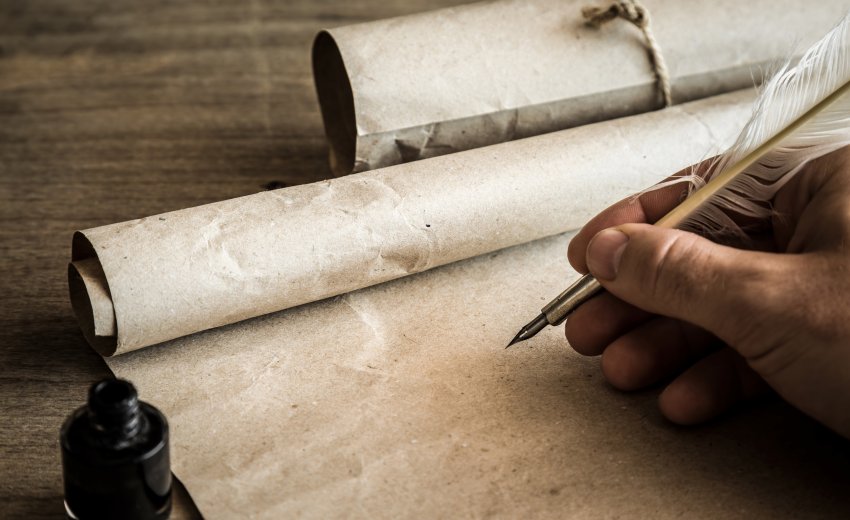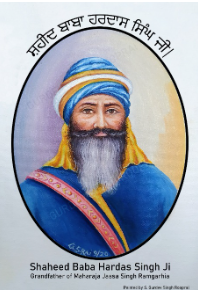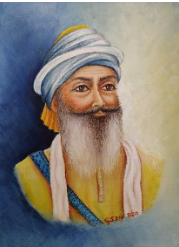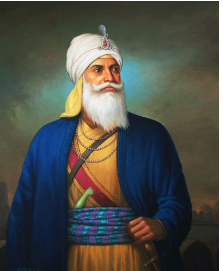In our sikh history, various historians have made significant alterations over time. Some changes are based on new research and sources, while others seem less credible and difficult to believe. Without substantial evidence or references, historical writings can become more like stories rather than factual accounts. There are many such instances, but here we will focus on Gen. Sardar Jassa Singh Ramgarhia, the 18th-century founder of the Ramgarhia Misl, and the allegations of female infanticide against him by some historians.
Looking into the background of Sardar Jassa Singh Bamrah, we find that his family had been connected to the Sikh Gurus since the time of the sixth Guru, Sri Guru Hargobind Ji. Bhai Bidhi Chand Chhina, a prominent Sikh warrior of that era, hailed from the village of Sur Singh (40 km from Amritsar on the Khem Karan road). Bhai Ramu Ji Bamrah, a neighboring blacksmith and carpenter, assisted Bhai Bidhi Chand in making weapons. Such was his admiration for Bhai Bidhi Chand Chhina that he named his own new born son Bidhi Chand as well. This deep devotion and love for the Guru's house permeated his family from that time onward. Later, a son was born to this Bidhi Chand Bamrah, named Hardas.(1)
Bhai Hardas Ji Bamrah received Amrit initiation( Khande di Pahul) from lotus hands of Sri Guru Gobind Singh Ji, becoming Hardas Singh. His son was named Bhagwan Singh, who later became renowned in the Sikh Panth as Giani Bhagwan Singh Bamrah. Both father and son served Guru Gobind Singh Ji in Anandpur Sahib. (2) In 1684, Baba Hardas Ji wrote a manuscript of the Adi Granth Sahib, authenticated by sri Guru Gobind Singh Ji himself with his signatures. (this manuscript was present in the Sikh Reference Library, Amritsar until 1984). Pleased with his service, the Guru blessed him with royal rewards (3)(4):
" ਇਨਕੋ ਬਡੋ ਸਿੰਘ ਹਰਦਾਸ, ਰਹਿੳ ਗੁਰੂ ਗੋਬਿੰਦ ਸਿੰਘ ਪਾਸ । ਮਨ ਤਨ ਧਨ ਕਰ ਸੇਵ ਕਮਾਈ, ਗੁਰ ਬਰ ਦੀਨੋ ਰਾਜ ਲਭਾਈ ”॥ (5)(Giani Gian Singh)
Hardas Ji participated in all the battles of Guru Gobind Singh Ji and later fought alongside Banda Bahadur, eventually achieving martyrdom in the Battle of Bajwara (Hoshiarpur).(6)
Giani Bhagwan Singh Ji ( son of Baba Hardas singh ji ), deeply devoted to the Guru, was known for his teachings on Gurbani and complete Sikhism, earning him the title of 'Giani Ji' from the people. He had five sons, the eldest being Jassa Singh. During Nadir Shah's invasion (1739-40), upon hearing the news, Khan Bahadur Zakariya Khan sought the Sikhs' help for military assistance. Giani Bhagwan Singh Ji, along with his son Jassa Singh and others, joined the battle. While saving Khan Bahadur's life, Bhagwan Singh was wounded and martyred. Impressed by their bravery, Khan Bahadur granted Jassa Singh and his brothers five villages: Valla, Verka, Sultanwind, Tung, and Chabba (Chabbal). (7)
Giani Bhagwan singh ji ( portrait by Gurdev singh Rooprai )
Sardar Jassa Singh Bamrah was, like his ancestors, a devoted follower of the Guru and a brave warrior. A great devotee of Guru Ram Das Ji, he named everything in the Guru's honor, such as Ram Rauni for the fort he built in Amritsar, and Ram Garh for the fortified structure he constructed. He called his langar "Ram Roti," his weapons "Ram Ban" and "Ram Jange," and his treasury "Ramras." He even named his Misl, the Ramgarhia Misl.(8) His bravery and foresight were well-recognized among the Misls and the Panth. His life exemplified protecting others, providing refuge, and fighting alongside the Khalsa in every major battle. His character included safeguarding the honor of women and taking a stand for the downtrodden.(9)
Attributing baseless allegations to such a significant figure without concrete evidence tarnishes not only their legacy but also disrespects the sacrifices made by these great warriors. This principle applies not only to Sardar Ramgarhia but to any prominent figure in the Panth. Unfounded accusations without substantial proof are unjust. After all, it is due to the sacrifices of these generals and warriors that we live with our heads held high today.
Maharaja Jassa singh Ramgarhia. ( portrait by Artist R.M.singh Chandigarh )
Let's explore the historical allegations against Sardar Jassa Singh Ramgarhia regarding the killing of a girl. Efforts have been made to keep the discussion brief to avoid making the article overly long. Many questions arise regarding the writings of authors, but the attempt is to delve into minimal details.
No Persian sources from antiquity mention any incidents of Sardar Jassa Singh Ramgarhia killing girls. The first mention appears in "Prachin Panth Prakash" by Ratan Singh Bhangu, first published in 1858. Here S. Bhangu ji describes only a small hint in single line only.
"ਸਿੰਘ ਤਰਖਾਣ ਜੱਸਾ ਸਿੰਘ ਜੋਇ, ਦੀਨੋ ਸਿੰਘਨ ਛੇਕ ਥੋ ਸੋਇ । ਸੋ ਆਇ ਦੀਨਾ ਬੇਗ ਪੈ ਰਹਾ, ਸਿੰਘ ਸੇ ਕਰੋ ਉਸ ਸੰਗ ਅਹਾ" II 45 II (10)
Here, Bhangu ji does not provide any specific reason, date, month, or place for the incident. When making allegations, it is crucial to mention evidence.
Ratan Singh Bhangu's father, Bhai Rai Singh, was raised by Sardar Sukkha Singh Kalsi (Tarkhan Madi Kamboji) because he was the son of Bhangu's father's close friend, Sardar Mehtab Singh Bhangu (Miran Kotia). After his martyrdom, Rai Singh was targeted by Mughal forces but survived and was raised by Sardar Sukkha Singh as his son. Bhangu mentions this entire episode in his book "Prachin Panth Prakash."(11)
Bhangu writes that he has documented what he heard from elders. In the entire text, there are only two references to the bravery of the Ramgarhia clan: Sardar Jassa Singh Ramgarhia and Sardar Sukkha Singh Kalsi (Madi Kamboji), with over ten chapters and around 500 stanzas dedicated to them. There is only one episode of Bhangu's father, Sardar Mehtab Singh, slaying Massa Ranghar in the Golden Temple with Sardar Sukkha Singh. This context could have led to some bias against the Ramgarhias, hence, the few disparaging remarks.
Bhangu ji mentions ,that when Sardar Jassa Singh's brother Mali Singh captured Sardar Jassa Singh Ahluwalia, Sardar Jassa Singh Ramgarhia was angry at his brother and treated Ahluwalia with respect and released him with appropriate gifts. Bhangu's choice of words in some contexts raises doubts about his intentions, as seen in:
“ ਇਸੇ ਮਾਹਿਂ ਇਕ ਔਰ ਹੀ ਸੁਣੋ ਜੁਲਮ ਕੀ ਗਲ । ਰਾਮਗੜ੍ਹੀਏ ਜਿਮ ਵੱਧ ਘਣੇ ਗਏ ਖੇਹ ਮੇ ਰਲ ”॥ (12)
The next significant mention is in "Sri Guru Panth Prakash" by Giani Gian Singh, first published in Delhi in 1880 and available in a 1987 edition by the Language Department. Gian Singh JI provides a comprehensive account of the Ramgarhia Misal. He describes how Sri Guru Gobind Singh Ji blessed Baba Hardas Ji with prosperity, and later, how Sardar Jassa Singh participated in battles against Nader Shah and was granted five villages as a reward for his bravery. Gian Singh mentions:
“ਫੇਰ ਅਦੀਨਾ ਬੇਗ ਕੇ ਪਾਸ ਰਹੋ ਇਹ ਜਾਏ । ਜੰਗ ਰਾਮਗੜ੍ਹ ਕੈ ਵਿਖੇ ਮਿਲਿਯੋ ਪੰਥ ਸੋ ਜਾਇ ।I 5 ।I ਕਿਲ੍ਹਾ ਰਾਮਗੜ੍ਹ ਇਨੀਕੋ ਬਕਸ਼ ਪੰਥ ਨੈ ਦੀਨ । ਨਾਮ ਰਾਮਗੜ੍ਹੀਏ ਭਣੋ ਇਸੀ ਹੇਤ ਤੈ ਚੀਨ ” I। 6 ।I (13)
Further he describes the construction of the Ram Raouni fort and the siege led by Adina Beg. He recounts how Sardar Jassa Singh entered the fort to aid his fellow Sikhs, emphasizing his devotion to the Panth:
“ ਠਟੀ ਸ਼ਹੀਦੀ ਲੈਨ ਸਿੰਘਨ ਜਬ ਐਨ ਪੁਕਾਰਾ । ਜੱਸਾ ਸਿੰਘ ਤਰਖਾਣ ਸਿੱਖ ਗੁਰੁ ਸਿਦਕੀ ਭਾਰਾ । ਨੌਕਰ ਦੀਨਾ ਬੇਗ ਪਾਸ ਥਾ ਬਹੁ ਦਿਨ ਕੇਰਾ। ਸੰਗ ਤਾਹਿ ਅਸਵਾਰ ਏਕ ਸੌ ਸਿੰਘ ਅਛੇਰਾ । ਤਿਸ ਨੇ ਸੁਣ ਮਨ ਧਰੀ ਸਿੰਘ ਸਭ ਲੈਹੇਂ ਸ਼ਹੀਦੀ । ਫੇਰ ਮੋਹਿ ਨ ਤਜੇ ਤੁਰਕ, ਮਾਰਿਹ ਕਰ ਗੀਦੀ । ਤਾਂਤੇ ਚਾਹੀਏ ਅਬੀ ਪੰਥ ਸੋ ਮਿਲ ਕਰ ਮਰਨਾਂ । ਵਿਛੁੜ ਪੰਥ ਤੇ ਰਹਿਨ ਖੇਤ ਮੇ ਜੈਸੇ ਡਰਨਾ ” ॥17॥ (14)
In the provided text, there is no mention of any allegations against Jassa singh Ramgarhia regarding the killing of a girl. Giani ji Instead, it is stated that when Sardar Jassa Singh learned about the condition of the Sikhs inside the fort, he immediately went inside the fort to help his Sikh brotherens, leaving Adina Beg. Giani: Gian Singh Ji spent 20 years researching and writing this book.
Another manuscript by Giani Gian Singh Ji is "Twarikh Guru Khalsa Part 3 Raj Khalsa" (first printed in 1892). Pages 548 to 556 discuss the Ramgarhia Misl. Interestingly, Giani Ji does not mention any allegations against Sardar Jassa Singh Ramgarhia regarding the killing of a girl; instead, he praises his bravery everywhere. At the beginning of episode , he describes about Jassa Singh's father, Giani Bhagwan Singh.
" In Samvat 1797 (1739-40 AD), during Nadir Shah's invasion, he saved Khan Bahadur's life by sacrificing his own, for which the Nawab appointed his son Jassa Singh as Sardar and granted him revenue-free land in Valla, Verka, Tung, Sultanwind, and Chabba (five villages). Once, as a representative( vakil ) of sikhs regarding the case of Shah Nawaz, he went to Adina Beg. Seeing him as handsome, young, brave, and charming, Adina Beg kept him by his side by accepting his demands on behalf of Khalsa. Later, during the battle of (Ram Rauni), when Adina Beg came to fight the Sikhs, Jassa Singh joined the Khalsa with his hundred horsemen. This angered Mir Mannu, who took away those parganas from him. However, the Khalsa greatly honored him and granted him the fort of Ramgarh, making him famous as Ramgarhia." (15)
Readers can understand that Giani Gian Singh Ji did not mention the incident of killing a girl or being excommunicated from the Panth. Remember that at that time, the various Sikh jathas were independent and operated in their own ways; none were under any single authority. (By 1747-48, the number of Sikh jathas had reached 65. The formation of Misls occurred during Vaisakhi in 1748). In this regard, Hari Ram Gupta mentions Ali-ud-Din's "Ibrat Nama" about above incident in the foot note of his book History of the Sikhs. (16)
In the second part of "Twarikh Guru Khalsa," "Shamsher Khalsa,", when discussing the battle of Ram Rauni, Giani Ji writes, "At one time, a true or lie rumor spread about Jassa Singh, that a daughter was born in his house, whom his wife had aborted. Due to this, the Panth excommunicated him. "(17) This statement indicates that Giani Ji himself is not certain. That’s why he does not mention this incident while discussing the Ramgarhia Misl on page 549, especially not in "Panth Prakash." This is something readers should consider.
Now, let's discuss Bhai Kahn Singh Nabha's book "Mahan Kosh," first published in 1930. Bhai Sahib holds great respect in the Sikh Panth and has received the Padma Bhushan award. In his book, he provides detailed information based on facts and sources. Every 20th-century writer uses this book as a source. However, for some unknown reason, he included this baseless, hearsay incident in his book, attempting to defame this great general by putting a slanderous allegation on him. He does not mention the source of his information. This can only be attributed to hatred towards the Ramgarhia community. A scholar like him should have conducted thorough research on this matter.
"This was the son of Giani Bhagwan Singh. He was skilled in martial arts and very brave. The Khalsa Panth excommunicated him for the stigma of killing a girl. He then went to serve Adina Beg with his brothers." (18)
See how he states that the Khalsa put a stigma on him, meaning there is a difference between being actually stigmatized due to events and having a stigma put on you. This clearly shows that these incidents were fabricated by writers to include them in their books with the intention of defaming him. Bhai Kahn Singh Nabha should have mentioned the date and time of such events. If someone is excommunicated or declared a Tankhaiya by the Panth, then the name of the place, time, and the names of the leaders of the Khalsa who imposed the punishment should have been mentioned. But lies are lies.
Baba Prem Singh Hoti Mardan ,was also a renowned historian. In his writing ("Khalsa Raj De Usaraiye Part 2, 1942"), he mentions Sardar Jassa Singh Ramgarhia. On page 80, in a footnote, he writes:
"In 'Shamsher Khalsa,' it is written that Sardar Jassa Singh Ramgarhia killed his daughter. Due to this allegation, the Panth separated him. But we did extensive research and found no solid evidence to support this. When we look into his life's actions, it becomes clear that someone who holds such respect and compassion for others' daughters and puts himself in danger to save their lives could not possibly strangle his own daughter." (19)
On the same page 80, Baba Prem Singh Ji describes an incident in 1780, where the governor of Hisar abducted a poor Brahmin's daughter, and when the Brahmin pleaded with Sardar Jassa Singh Ramgarhia , he immediately attacked the governor of Hisar, rescued the girl, punished the governor appropriately, and gave the girl 5000 rupees as a token of blessing, saying daughters should not be sent away empty-handed. This was the character of Jassa Singh Ramgarhia. (20)
Another example is by Sardar Prithi Pal Singh Kapoor, who in his book ("Sardar Jassa Singh Ramgarhia 1957") comments on this incident in a footnote on page 36:
"It is noteworthy that earlier writers did not mention this at all. Especially Ali-ud-Din did not write anything about this incident in his book 'Ibrat Nama." (21)
From all the above references, it is clear that this entire fabricated story was concocted only to defame Maharaja Jassa Singh Ramgarhia and to quench the burning envy and hatred towards him.
Let's now look at how other writers have altered the content of Giani Gian Singh Ji's "Panth Prakash" and "Twarikh Khalsa" to distort history and tarnish Giani Gian Singh's name.
Giani Gian Singh's "Sri Guru Panth Prakash," edited by Giani Kirpal Singh Ji in its 1974 edition.
“ਸੁਤ ਭਗਵਾਨ ਸਿੰਘ ਕੇ ਚਾਰੋ, ਭਏ ਬਡੇ ਜੱਸਾ ਸਿੰਘ ਦਾਰੋ। ਤਾਰਾ ਸਿੰਘ ਆਲੀ ਸਿੰਘ ਜਾਨੋ । ਅਰ ਖੁਸ਼ਹਾਲ ਸਿੰਘ ਪਹਿਚਾਨੋ ॥60॥ ਜੱਸਾ ਸਿੰਘ ਨਿੱਜ ਬੇਟੀ ਮਾਰੀ । ਸੁਣੀ ਖਾਲਸੇ ਪੰਥ ਮਝਾਰੀ । ਪੰਥ ਖਾਲਸੇ ਵਰਤਨ ਤਿਆਗੀ । ਗੁੱਸਾ ਖਾਇ ਤਖਾਣ ਅਭਾਗੀ ” ॥61॥ (22)
"Bhagwan Singh's four sons grew up to be Jassa Singh, Tara Singh, Ali Singh, and Khushal Singh. Jassa Singh killed his own daughter, and the Khalsa Panth was informed. The Khalsa Panth abandoned him, and in anger, he was termed unfortunate."
However, the same writter in the 2019 edition changes the language about this incident.
“ਜੱਸਾ ਸਿੰਘ ਤਖਾਣ ਸਿੱਖ, ਇਕ ਥਾ ਗੁਰੂ ਕੇਰਾ । ਨੌਕਰ ਤੁਰਕਨ ਪਾਸ, ਰਹਿਤ ਥਾ ਬਹੁ ਦਿਨ ਕੇਰਾ । ਥਾ ਤਨਖਾਈਆ ਸੋਊ, ਪੰਥ ਨੇ ਤਿਆਗ ਦੀਉ ਥਾ । ਨਿਜ ਬੇਟੀ ਕਾ ਖੂੰਨ , ਤਾਹਿਂ ਕੇ ਹਾਥ ਭਣੋ ਥਾ ”॥ 105 ॥ (23)
"Jassa Singh Thakan was a Sikh who served the Guru. He worked for the Turks for many days and was excommunicated by the Panth. He was accused of killing his own daughter, and his hands were stained with her blood."
Readers can see that the event mentioned by Giani Gian Singh Ji in the 1974 edition is not present in the same form in the 2019 edition. It appears that the narrative was altered to mislead the community, suggesting that details omitted in 1974 were added in 2019 to influence readers' perceptions. Even if it is accepted that Giani Gian Singh mentioned this in "Shamsher Khalsa," Giani Kirpal Singh Ji should have credited the writing to Shamsher Khalsa by Giani Gian Singh. Instead, they altered the text significantly while still attributing it to "Sri Guru Panth Prakash" by Mahakavi Giani Gian Singh, which seems deceptive.
Other historians like Hari Ram Gupta, Principal Satbir Singh, and Dr. Ganda Singh have discussed this issue, though often in brief or footnotes. Most references are to Rattan Singh Bhangu and "Panth Prakash" edited by Giani Kirpal Singh, which confirms that the accusation against Maharaja Jassa Singh Ramgarhia of killing his daughter is unfounded and appears to be a conspiracy to defame this great general.
The Sikh community should strongly oppose such narratives and request the SGPC to correct these texts to ensure accurate historical information reaches the Panth. New writers should also be urged to avoid describing events without complete and solid evidence. The Sikh history has already seen suffering from significant alterations, so it is crucial to remain vigilant. Our intention is not to offend anyone but to hope for an accurate history.
1 Baba Hardas Singh ji Page 9, ( Ranjit singh Rana UK), Tawarikh Ramgarhia Page 100, (Dr. Amarjit Kaur Bamrah)
2 Tawarikh Ramgarhia Page 100-101,( Dr. Amarjit kaur Bamrah)
3 Article on Adi Granth sahib & Dasam Granth ,by Dr. Anurag singh. ( 14 March 2016 )
4 Sri Guru Panth Parkash , Page 1172, ( Giani Gian Singh )
5 Sri Guru Panth Parkash , Page 1172, ( Giani Gian Singh )
6 Tawarikh Ramgarhia Page 102-103,( Dr. Amarjit kaur Bamrah), Tawarikh Guru Khalsa Page 548, Pathar Chhap, ( Giani Gian Singh).
7 Tawarikh Guru Khalsa pathar chhap vol. 3, page 549, ( Giani Gian singh)
8 Khalsa Raj de Ussraiye, Vol. 2, p. 78, ( Baba Prem Singh Hoti Mardan)
9 Khalsa Raj de Ussraiye, Vol. 2, p. 78, ( Baba Prem Singh Hoti Mardan)
10 Prachin Panth Parkash page 328, stanza 45, ( Rattan singh Bhangu )
11 Preface Prachin Panth Parkash ( Rattan singh Bhangu )
12 Prachin Panth Parkash page 391, ( Rattan singh Bhangu )
13 Sri Guru Panth Parkash page 1172-77, ( Giani Gian Singh )
14 Sri Guru Panth Parkash page page 798-99, ( Giani Gian Singh )
15 Tawarikh Guru Khalsa Bhag 3 page 549 , ( Giani Gian singh )
16 History of the Sikhs 1739-1768, pages 47-48 foot note, ( Hari Ram Gupta )
17 Tawarikh Guru Khalsa page 472, ( Giani Gian singh )
18 Mahan Kosh page 497, ( Bhai Kahn Singh Nabha )
19 Khalsa Raj de Usrayie vol 2 page 80, foot note. ( Baba Prem singh Hoti Mardan )
20 Khalsa Raj de Usrayie vol 2 page 80, foot note. ( Baba Prem singh Hoti Mardan )
21 Sardar Jassa Singh Ramgarhia ( 1957) page 36, Foot note .( Prof. Prithipal Singh Kapoor )
22 Sri Guru Panth Parkash (Giani Gian singh) Edited by Giani kirpal singh ( 1974) vol 4, page 2665.( Giani Kirpal singh)
23 Sri Guru Panth Parkash (Giani Gian singh) Edited by Giani kirpal singh ( 2019) vol 4 , page 2314-15.( Giani Kirpal singh)




